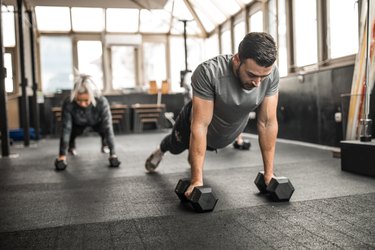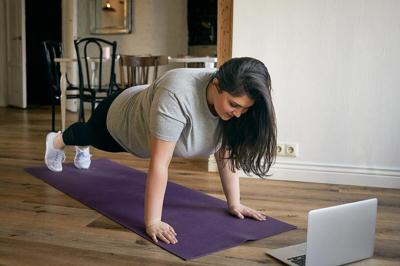Mobility in the hips and ankles directly affects how well you walk, squat, climb stairs, and maintain balance. When these joints are tight or restricted, movement becomes less efficient and more prone to strain or injury. Poor mobility can affect posture, cause joint compensation, and lead to discomfort in the knees, back, or feet.
The good news: you don’t need to be an athlete or join a gym to restore mobility. Targeted, low-impact movements done consistently can significantly improve joint health. Here are specific, practical hip and ankle mobility exercises you can do at home to regain smooth, pain-free motion in daily life.
HIP MOBILITY EXERCISES
1. 90/90 Hip Switches
What it targets: Internal and external hip rotation
How to do it:
- Sit on the floor with one leg bent in front of you at a 90-degree angle and the other behind you in the same position.
- Sit upright and slowly rotate your knees to the opposite side, switching leg positions without lifting your feet.
- Perform 6–10 controlled reps.
Why it works: This improves rotational movement in both hips, which helps with walking and turning without discomfort.
2. Hip Flexor Stretch (Lunge Position)
What it targets: Front hip muscles and iliopsoas
How to do it:
- Step one foot forward into a lunge, keeping the back knee down and torso upright.
- Shift your weight forward slightly while keeping the hips square.
- Hold for 30 seconds and repeat on the other side.
Why it works: Prolonged sitting shortens hip flexors. Stretching them improves posture and stride length.
3. Glute Bridges
What it targets: Glutes, hip extensors, and core stabilizers
How to do it:
- Lie on your back with knees bent and feet flat on the floor, hip-width apart.
- Press through your heels to lift your hips until your body forms a straight line from shoulders to knees.
- Pause at the top for 2 seconds and slowly lower back down.
- Complete 10–12 repetitions.
Why it works: Strong glutes stabilize the hips and take pressure off the lower back and knees.
4. Standing Hip Circles
What it targets: Joint mobility and hip stabilization
How to do it:
- Stand near a wall or chair for support.
- Lift one leg slightly off the floor and move it in a slow, controlled circle from the hip joint.
- Perform 5–8 circles in each direction per leg.
Why it works: Maintains fluid movement in the hip joint and improves control and balance.
ANKLE MOBILITY EXERCISES
5. Ankle Rockers
What it targets: Dorsiflexion (the ability to flex the ankle upward)
How to do it:
- Stand facing a wall with one foot a few inches away from it.
- Bend your front knee toward the wall while keeping the heel down and the foot flat.
- Try to touch the wall with your knee without lifting your heel.
- Repeat 10 reps per ankle.
Why it works: Dorsiflexion is critical for walking, climbing stairs, and squatting safely.
6. Seated Ankle ABCs
What it targets: Multi-directional ankle mobility
How to do it:
- Sit in a chair and extend one leg slightly off the floor.
- Use your toes to “write” the alphabet in the air.
- Repeat on the other foot.
Why it works: This non-weight-bearing movement helps reintroduce motion in multiple planes, essential for ankle health and injury prevention.
7. Heel-to-Toe Walk
What it targets: Ankle flexibility, coordination, and balance
How to do it:
- Walk across the room by placing one foot directly in front of the other, heel to toe.
- Take slow, deliberate steps and engage your core.
- Walk 10–15 steps in each direction.
Why it works: Encourages smooth ankle transitions and builds neuromuscular control for better gait mechanics.
8. Calf Stretch on Wall
What it targets: Achilles tendon and soleus/gastrocnemius flexibility
How to do it:
- Stand facing a wall with both hands pressing into it.
- Step one foot back and press the heel into the floor.
- Keep the back leg straight and lean into the stretch.
- Hold for 30 seconds per leg.
Why it works: Tight calves limit ankle mobility. This stretch improves range and reduces stress on the ankle joint.
How to Practice Safely
- Warm up: Gentle marching or leg swings for 2–3 minutes before starting helps blood flow to the joints.
- Keep movements slow and controlled: Avoid jerking or bouncing.
- Focus on form: Quality matters more than depth of stretch.
- Modify if needed: Use support like chairs or cushions for comfort.
- Consistency is key: 10–15 minutes a few times per week can lead to noticeable changes in how you move and feel.
The Connection Between Hip and Ankle Mobility
While the hip and ankle are separate joints, they influence each other. If the ankle lacks range, the knee may twist or the hip may overcompensate during walking. Similarly, tight hips can reduce stride length and make ankle motion more abrupt. Improving both areas together creates a smoother, more efficient chain of movement from the ground up.
This matters not just for athletes but for everyday tasks like walking up stairs, rising from a chair, or getting in and out of a car. Restoring mobility means moving more confidently—and with less pain or restriction.
Final Thoughts
Better movement starts at the foundation. Taking time to improve hip and ankle mobility can reduce discomfort, increase independence, and help you move more smoothly through your day. These exercises are safe, low-impact, and require no special equipment. All you need is commitment and a few minutes each day.
Small effort. Big results. Start with a couple of these exercises today—and notice how your body thanks you tomorrow.
:max_bytes(150000):strip_icc()/Hip-Mobility-Exercises-Thatll-Keep-You-Feeling-Limber-GettyImages-1160328949-2000-cb74c1a7a79e4b8d98abfc2ecfbcd35e.jpg)


:max_bytes(150000):strip_icc()/resistance-band-exercises-workout-moves-2000-d08565f9ac4d4b748e1a777e3a636eb2.jpg)




